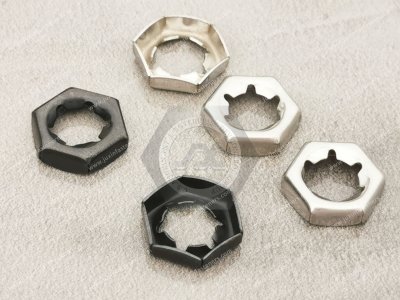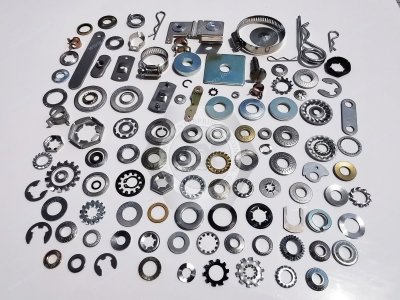Call Us
+86 136 6007 9809
Call Us
+86 136 6007 9809
Oct. 09, 2023
DIN7967 Self-Locking Counter Nuts are generally not used as the primary stress fasteners; their role is to fasten on the nut to prevent the DIN7967 Self-Locking Counter Nuts from loosening. The fastening nut is mainly used as a lock nut. When used, the first ordinary nut is to be connected to the fastening and then twisted on the fastening locknut and hand-tightened so that it is in contact with the standard nut, and use a wrench to tighten the fastening nut 60 ° ~ 90 ° can be. When loosening, the hexagonal nut must be drawn. Make the gap with the fastening nut; you can reduce the lock nut. din767 Self-Locking Counter Nuts is a single-button elastic locking nut, often used as a secondary nut in the double-nut locking structure. Because it weighs only 30% of a standard nut, it is suitable for aerospace and related applications. The DIN7967 Self-Locking Counter Nuts M5mm jam nut is one of the parts produced by our factory. It is mainly used to unlock a specific connector device, for which notched bolts and hexagonal nuts are usually used. It connects the separating surface between the bracket, flat tube assembly, and the pair of articulation. The material of the fastening nut is 60Si2Mn, the thickness of the material is 0.4mm, and it is a plate forming part, so it is best to use the stamping forming process to realize its forming by using a mold. The primary method is as follows: drop forming of the unfolded size, bending of the shape, and thread profile. The peripheral hexagonal vertical edge is not a problem to be formed by the die, but how to start the center spiral surface is the key to the production of the part. The center spiral is made up of six segments, which creates the necessary conditions for the three-dimensional forming of the sheet. When the mold is closed, the mold protrusion and concave mold fit to make the six segments of the material edge around the central axis spiral up at 360 ° to complete a molding pitch by forming the mold to complete the molding.
DIN7967 Self-Locking Counter Nuts mold design industrial solutions
Based on process analysis, mold design should take the appropriate measures. Adopt small clearance progressive die side edge fixed step punching nut unfolding blanks to ensure the relative positional accuracy of the inner hole and the outer shape, burr height control in 0.03mm or so, bending and forming composite mold central part of the structure schematic diagram as shown in the following figure, "bending and forming composite mold" shown. The mold frame adopts the standard one-level precision mold frame. Considering the processing technology of the mold zero and the difficulty of the mold assembly, the use of polyurethane rubber and aviation rubber, two kinds of rubber combination for its elasticity of the concave mold; polyurethane rubber due to the high Shore hardness is placed on the surface of the contact with the material, aviation rubber compression is placed on the bottom surface of the polyurethane rubber. Combining the two is advantageous for molding and overcomes the contradiction of low compression. Billet positioning is the use of a billet center hole and card point positioning plate to implement a three-point positioning so that the center of the billet not only coincides with the center of the mold but also controls the rotation and movement of the billet.
What are the uses of DIN7967 Self-Locking Counter Nuts?
Buckling nuts usually connect two parts with an inevitable friction to prevent loosening or falling off. Typical applications include mechanical equipment, automotive, aerospace, and other fields. Using fastening nuts increases the connection's tightening force and improves the connection's stability.
DIN7967 standard on the requirements of the Self-Locking Counter Nut
1. Material requirements: fastening nuts can be made of stainless steel, carbon steel, and other materials and should meet the requirements of the relevant material standards;
2. Appearance requirements: the surface of the fastening nut should be free of cracks, burrs, corrosion, and other defects;
3. Dimensions and mechanical properties: the dimensions and mechanical properties of the fastening nut should meet the requirements of the standard, such as thread size, axial tensile strength, etc.;
4. Product grade: fastening nuts can be divided into general and high-strength levels according to their performance;
5. Inspection method: The fastening nuts should be inspected using the methods specified in the standard to ensure their quality.


DIN7967 Self-Locking Counter Nuts need to pay attention to what problems?
1. Correct installation: DIN7967 Self-Locking Counter Nuts should be based on the need to select the appropriate thread specifications and models to ensure the correct installation in the parts to be connected;
2. Appropriate pre-tensioning: When using DIN7967 Self-Locking Counter Nuts, they need to be pre-tensioned appropriately, but not over-tightened, so as not to cause deformation or damage to the parts
3. Pay attention to the torque: the installation and disassembly of DIN7967 Self-Locking Counter Nuts should be carried out according to the range of torque specified in the standard; too high or too low a torque will hurt the connection;
4. Inspection and maintenance: Regularly check the status of DIN7967 Self-Locking Counter Nuts to ensure that they work correctly, and repair or replace them in time if they are found to be loose or abnormal;
5. Reasonable storage: DIN7967 Self-Locking Counter Nuts should be stored to avoid humidity, corrosive gases, and other environments. Please pay attention to the storage classification so as not to affect its quality and service life.
In practical application, the requirements in the standard should be strictly adhered to. The materials and specifications of DIN7967 Self-Locking Counter Nuts should be reasonably selected. Attention should be paid to the correct installation and use method to ensure the connecting parts' stability and reliability. The ordinary hexagonal nuts will be fastened to the connected parts, then twisted on the fastening nut, and tightened by hand to make it in contact with the supporting surface of the ordinary nut. Then use a wrench to pull it 60-90 degrees can be loosened; when loosening the fastening nut, you must then tighten the joint hexagonal nut to make it and the DIN7967 Self-Locking Counter Nuts between the gap before loosening the DIN7967 fastening nut so as not to scratch the threads of the bolt.DIN7967 fastening nut is not generally used as the leading force fastener, and its role is to be fastened to prevent the nut from loosening the nut.DIN7967 fastening The nut is used with the petals facing up so that the friction ring in the middle of the DIN7967 Self-Locking Counter Nuts tops the threads, thus playing the purpose of anti-loosening. A buckling nut is a lock nut with mechanical anti-loosening, generally used with a spring spacer, used mainly in lightweight mechanisms. It can be substituted in emergencies. Considering the convenience, safety, economy, and other factors, replacing it is generally not recommended.
If you are looking for high-quality fastener screws & all kinds of spring washers or technical support for structural design, please get in touch with me. Thanks.
Email: sales@jxfastener.cn,
My Whats App:+86 13660079809,
Website:www.juxinfasteners.com。
Facebook / INS:adelajonly@gmail.com
Contact Us
Tel.:
+86 020 8621 0320
+86 020 3121 6067
Technical Support:
Navigation
SEND INQUIREY